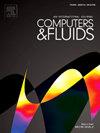An enhanced analytical-based geometry processor for the volume of solid (VoS) method in CPU and GPU computations
IF 3
3区 工程技术
Q3 COMPUTER SCIENCE, INTERDISCIPLINARY APPLICATIONS
引用次数: 0
Abstract
This paper introduces an analytical–based geometry processor which improves the efficiency of volume-of-solid (VoS) CFD solvers for fluid–structure interaction (FSI) scenarios with rigid body motion. The combination of the VoS method and the direct forcing immersed boundary (DFIB) method speeds up geometry creation while significantly reducing computational workload during unsteady simulations of solid structure movement or deformation. The proposed geometry processor’s effectiveness is demonstrated in the vortex-induced vibrations (VIV) scenario of a single circular cylinder, where the geometry was dynamically modified at each timestep to correspond to the cylinder’s passive motion. Comparisson studies show that the enhanced VoS function accelerates geometry construction process significantly faster than the ray-casting method while maintaining the same level of accuracy. Furthermore, its GPU implementation consistently achieves significant speedup across various computational loads, indicating superior scalability. This proposed method not only works well for simple geometries, but it also supports a wide range of multi-body curvilinear forms, including extruded spans and fully defined 3D geometries, making it suitable for a variety of applications.

一种增强的基于解析的几何处理器,用于CPU和GPU计算中的固体体积(VoS)方法
本文介绍了一种基于解析的几何处理器,它提高了固体体积(VoS) CFD求解刚体运动流固耦合(FSI)场景的效率。VoS方法与直接强迫浸入边界(DFIB)方法的结合加快了几何图形的生成速度,同时显著减少了实体结构运动或变形非定常模拟的计算量。该几何处理器的有效性在单个圆柱体的涡激振动(VIV)场景中得到了验证,在每个时间步动态修改几何形状以对应圆柱体的被动运动。对比研究表明,增强的VoS函数在保持相同精度的同时,显著加快了几何构造过程。此外,它的GPU实现在各种计算负载下始终实现显着的加速,表明优越的可扩展性。这种方法不仅适用于简单的几何形状,而且还支持各种多体曲线形式,包括挤压跨度和完全定义的3D几何形状,使其适用于各种应用。
本文章由计算机程序翻译,如有差异,请以英文原文为准。
求助全文
约1分钟内获得全文
求助全文
来源期刊

Computers & Fluids
物理-计算机:跨学科应用
CiteScore
5.30
自引率
7.10%
发文量
242
审稿时长
10.8 months
期刊介绍:
Computers & Fluids is multidisciplinary. The term ''fluid'' is interpreted in the broadest sense. Hydro- and aerodynamics, high-speed and physical gas dynamics, turbulence and flow stability, multiphase flow, rheology, tribology and fluid-structure interaction are all of interest, provided that computer technique plays a significant role in the associated studies or design methodology.
 求助内容:
求助内容: 应助结果提醒方式:
应助结果提醒方式:


